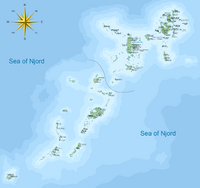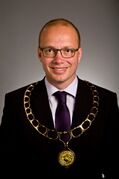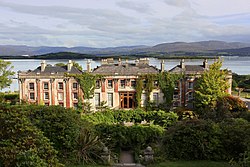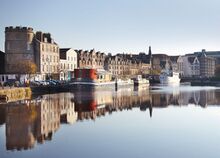Tårnøerne
This article is incomplete because it is pending further input from participants, or it is a work-in-progress by one author. Please comment on this article's talk page to share your input, comments and questions. Note: To contribute to this article, you may need to seek help from the author(s) of this page. |
| Disputed island Native name: Tårnøerne (Tynic) Turneyjar (Laugarán) Tower Ilands (Anglish) | |
|---|---|
 View of the south from Neskaupstaður | |
| Geography | |
 | |
| Location | Sea of the Njord (Nordania) |
| Total islands | 476 (39 inhabited) |
| Major islands | Vágar, Norðeyja, Sørøya |
| Area | 7255 km² |
| Highest point |
|
| Administered by | |
| Sjealand | |
| Realm | Helheim |
| Claimed by | |
| Ambrose | |
| County | Towers Ilands |
| Demographics | |
| Population | 142,907 (as of 2017) |
| Density | 19/km²/km² |
| Ethnic groups | Laugaráns, Ambrosians |
The Tårnøerne (Anglish: Tower Ilands, Laugarán: Turneyjar) are a hypoborean archipelago in the Sea of the Njord, lying to the southwest of Ambrose and to the north of Swastria. The largest three groups of islands are the Stykkishólmur, Lagaurás, and Trumba islands, although several hundred smaller ones also make up the island chain. The Tårnøerne, lying on the edge of the Nordanian Shelf, are a constituent subdivision Helheim, a realm of the Archkingdom of Sjealand.
Continuously inhabited since the 8th century, the Tårnøerne have been central to many of Nordania's most important events. Dating as far back to the Ambrosian War of Liberation, the sovereignty of the islands has been heavily contested between Sjealand and Ambrose for over 300 years. A period of Ambrosian control and development following the Great War of the North was reversed by the Continental War, and with the exception of a brief occupation from 1970-71, the islands have since been under Sjealandic administration, though Ambrose still mantains a nominal territorial claim over the islands.
The population of the Tårnøerne is made up of mostly Laugarán people, and as such, the lingua franca of the islands is Laugarán, though Tynic also enjoys official status. Despite this, there remains a sizeable minority of Anglish-speaking Harwicker Ambrosian settlers, mainly concentrated the city of Ambrösihöfn (Anglish: Port Ambrose) and across the northernmost islands.
The Tårnøerne are dominated by their rugged terrain and their subpolar oceanic climate, with the rocky, infertile soil precluding large-scale agriculture. Instead, the islands have historically been home to a thriving fishing and whaling industry. In the past few decades, undersea oil drilling has also increased substantially.
History
Early settlement
Tuthinan trade center

Ambrosian rule
With the outbreak of the Great War of the North, Ambrosian President Godfred Crovan outlined the acquisition of the islands as one of his primary military goals. This had become possible with the Royal Sjealandic Navy's confinement port by late 1862, isolating the Royal Sjealandic Army's relatively few troops stationed on the islands. This allowed for a force under General George Amlodd to land on the central islands on February 3, 1863. With limited resources, Amlodd's forces avoided direct engagement with army strongholds and local militia, instead surrounding and besieging the capital of Stykkishólmur. Under the threat of naval bombardment, the city garrison surrendered the islands a week later, allowing the Ambrosians full control over the islands, who established martial law. The breakout of the Sjealandian fleet in late 1864 saw a renewed threat to the islands, however an 1865 landing attempting to recapture the southern islands was inconclusive and the Sjealandians withdrew.
The Congress of Dalganburgh formally saw sovereignty of the islands transferred to Ambrose. The Ambrosian military administration ended on February 10, 1868, and was replaced by the Thanedred of the Tower Islands, though it enjoyed less autonomy from Elsbridge than other thanedreds of the Confederal Republic, and Amlodd remained provisional governor until elections were held in 1875. While the Øic were allowed the choice between emigrating to Sjealand or accepting Ambrosian citizenship, the vast majority of the Tynic-speaking population was deported to Sjealand. In all, about 32% of the pre-war population (mostly ethnic Tynics) left the islands between 1867 and 1877.
Amlodd justified the population expulsion by the need to use to the Tynic residents' homes for Ambrosian settlers. With his backing, the confederal government offered land grants to Ambrosians who moved to populate the islands. This tactic was successful, and by 1877 the population had undergone a drastic demographic change, with Ambrosian settlers (mainly ethnic Harwickers making up 40.2% of the population and growing. The islands underwent a process of Anglicization, with towns, regions, and street names renamed to Anglish. Nevertheless, after the 1880s, restrictions were relaxed on the use of the Laugarán language, which was permitted as an official language and taught alongside Anglish in specially-designated areas where it was still spoken by a majority.
The post-war economy of the Tower Islands was undermined by the fact that, even without the Sjealandic monopoly, Ambrose and its small merchant fleet could not hope to make any significant profit in overseas trade with the Orient; thus the role of the islands as a trade center further diminished, with Tuthinan trade shifting to Sjealandic Vestmannaland. However, one resource Elsbridge saw in the island were the vast fisheries in its waters, with Crovan writing in 1862:
...focused on the East for the past century, the Tyns haven't even bothered to scratch the surface of their gold mine; a gold mine of cod, haddock, and whale.
With the arrival of experienced Ambrosian fishermen from the Scarfskerry Cape, fishing turned from a minor subsistence lifestyle into a massively-profitable industry. By 1890, analysts in Port Ambrose estimated in a report that the fisheries generated an amount of revenue exceeding the cost of local government. Packing houses and canneries became the dominant employers and the market towns of old became fishing harbors and whaling ports.

Worried of Sjealandic retribution, and noting the ease with which the islands fell in 1863, Ambrose established a significant military presence on the islands even after the end of martial law. The natural harbor at Stykkishólmur made it a prime location for a naval coaling station, with half of the Ambrosian Njord Squadron based out of it in 1915. The Confederal Army began an extensive program of seaboard defense, constructing fortifications on the island. Between 1867 and 1917, 14 different coastal forts were built, eschewing the pre-war system of masonry forts with the first modern concrete ones. In terms of armament, they were armed with large breech-loading cannons mounted on "disappearing carriages" as well as with the new 305 mm heavy mortars. This military buildup, decried as aggression by Asgård, reached its peak in the 1910s, when the Ambrosian garrison rivaled the entire population of the Trumba Islands.
Return to Sjealand
War of the Njord to present
Government

|

|
| Frederik VI Archking |
Søren Rommedahl Viceroy of Helheim |
The terms Tårnøerne and Tower Islands are both geographical descriptors, as the islands are not administrated as a singular entity. Instead, since the reoccupation by Sjealand in 1923, they have been divided into two municipal districts known as Fjórðungur (Camaines). Laugarás Fjórðungur consists of the southern islands, from Akrar (Acre) to Kolbeinsey, with the seat of government being the town of Laugarás. Utan Norðurs Fjórðungur (Outer North) consists of the northern islands, with the seat of government being in Ambrösihöfn (Port Ambrose). Proposals to amalgamate the two districts have been entertained in recent years, but are controversial due to their ethnic and cultural differences.
Each Fjórðungur is led by an Kosningarjarl (Walejarl, or "elected earl"), who presides over an elected council. These councils represent the different Deilds (Wards) of the island; both councils consist of independent councillors. The incumbent Kosningarjarls are Jens Símun Jónsson of Laugarás Fjórðungur and Osfred Godwinson of Utan Norðurs Fjórðungur.
Both Fjórðungur are part of the Viceroyalty of Helheim, and as such are under the authority of Viceroy Søren Rommedahl's government in Varhaugr; additionally, the Royal Sjealandic Defence has direct authority over the base areas of Laugarás AFB, Tjørnuvík AFB, and the Ambrösihöfn Naval Station. Aside from these, however, the two Fjórðungur enjoy substantial devolution from Varhaugr, such as the ability to jointly self-administer their own fishing waters and ferry links.
The islands are represented in the Rigsdag, making up 10 of Sjealand's 400 electoral circles; this number, which was increased from 4 in 1973, is significantly disproportionate to the population of the islands, making up 2.5% of national constituencies despite making up less than 1% of the country's population. This situation, which was instituted after the 1971 war as means to give the islands a larger voice, is controversial among mainlanders. All ten seats are occupied by the Tårnøernes Parti (Tower Islanders Party), a centrist regional interests group which holds 9 additional party list seats as of 2018.
Geography
Islands
North Islands
The northern group of islands, which make up the Utan Norðurs Fjórðungur, range from Djúpivogur (Strathcove Iland), the most northerly, to the uninhabited Gæsirhólmur (Gooseholm), the most southerly. The Utan Norðurs Fjórðungur comprises approximately two-thirds of the combined landmasses of the Tårnøerne, as well as 51.5% of their total population as of 2017 (49,788 people). The majority of this population resides in or around the urban centers of the three largest islands — Stykkishólmur (Stycksholm), Tjørnuvík (Thornwick), and Vagga — which are connected by a developed infrastructure of road and ferry links known as the "Northern Network".
Distinctive to these islands is their rugged, rocky terrain, making large-scale agriculture or animal husbandry difficult; instead, Utan Norður is dominated by fishing; small fishing hamlets, some with a permanent residency of less than 100, are present on most of the islands. Furthermore, the major urban centers of Ambrösihöfn, Stykkishólmur, and Skagaströnd (1st, 3rd, and 4th most populous, respectively) are the primary port cities of the Tårnøerne, all boasting deep natural harbors and extensive pier facilities. Ambrösihöfn itself is the eleventh-busiest port on the Sea of the Njord, and the fourth-busiest Sjealandic port.
The northern islands bear the most prominent vestiges of Ambrosian rule; despite emigration after the War of the Njord, the population is still largely Anglish-speaking, and much of the architecture and culture of these islands is directly descended from the occupation of the late-19th and early-20th centuries. Though Anglish is a co-official language throughout the islands, in the north it remains visible on maps and sign posts, and many place names are referred to by their Anglish, not their Laugarán, names. These factors are a significant reason that northern cities such as Ambrösihöfn make up the majority of the tourism of the islands.
South Islands
Climate
The islands are cold, windy, and relatively humid: according to Köppen classification system the islands are characterized by a subpolar maritime climate. Moderate and fairly uniform temperatures prevail throughout the year, and both winters and summers are relatively mild; this is largely due to the warming effects of the Njord currents. The resulting semi-permanent low pressure area that forms around the islands in winter months is known as the Tårnøerne Low, and is an important factor in the formation and strength of extratropical cyclones in the Njord Sea.
Precipitation on the islands is relatively common; the summer months are characterized by heavy rainfall, averaging X millimeters in Ambrösihöfn, and the rest of the year by moderate snowfall. Outside of the summer months, most days are principally overcast.
Demographics
After a drastic backslide in the 1970s, the population of the Tårnøerne has grown continuously since the census year of 1982; today it is home to 96,673 people, of which 92,393 consider themselves permanent residents. The former number constitutes under 1% of the country's population of 56.7 million.
Laugaráns make up approximately 56.1% of the population, or 54,330 people; they are primarily (though, again, not exclusively) concentrated on the southern islands. Ethnically, Laugaráns are closely related to other Haemaslandic peoples. Other Haemaslandic ethnic groups, such as Tyns (who number as the third-largest ethnic group at 3.1%), are also present; these are often mainlanders and are found primarily in large urban centers or as military members and dependents, although there remain native Tynic communities that survived the Ambrosian expulsions of the 1860s.
Approximately 37.1% of the population is descended from the Ambrosian settlement of the islands in the late 19th century; this segment of the population, numbering 35,865 in total, is largely (but not exclusively) concentrated in the northern islands. The vast majority of this group (96.7%, or 34,682 people) can claim ancestry with the Harwicker people of the Ambrosian south; the remaining 1.7% (609 people) are either mixed-race or fully Northumbrian, a Voragonevanic people in the Ambrosian north. Both groups are identified together as "Ambrosian" for national census purposes.
Population growth has slowed in recent years, largely due to industrialization efforts rendering small hamlets economically nonviable, and emigration from the islands has been on the rise. However, positive effects of industrialization have tied the islands together with new infrastructure for road and ferry links, which has been credited with bringing both of the major ethnic groups together and reversing decades of sectarianism.
Languages
Since the late 19th century, the islands have been dominated by two different languages, Anglish and Laugarán, which have been designated official languages by both of the Fjórðungur. Islanders are expected to be proficient in both tongues, as well as in Tynic, the official language of the Archkingdom; the everyday vernacular, however, is different in different parts of the islands.
On the northern islands, the majority language is Anglish. While Anglish had been spoken on the islands for centuries, it only became a vernacular in the north after the Ambrosian settler colonialism of the 1870s and 1880s. Though the amount of speakers decreased dramatically over the course of the 20th century, the 2017 national census found that 76% of children born in Utan Norðurs Fjórðungur learned Anglish as their first language; this was followed by 11% having learned Laugarán and 10% having learned Tynic. Also vestiges of Ambrosian settlement, there are small Northumbric-speaking minorities in the north, primarily centred on Hamravík (Hammerwick) island; despite being spoken natively by over 500 people, Northumbric is not recognized in any official capacity by either the local or national governments.
On the southern islands, the majority language is Laugarán, very similar to the Øic language spoken on Vestmannaland; 83% of children born in Laugarás Fjórðungur learned Laugarán as a native language. The southern islands are also home to the only native communities of Tynic speakers on the archipelago, mainly on Akrar and Hov islands (most of the other Tynic speakers are temporary residents, predominantly military members).
Economy
Energy
Fishing and Whaling
Fishing, originally a subsistence occupation, expanded into a massive industry in the 1870s and remains a major part of the islands' economy today — around 30% of the islands' GDP. Offshore fishing by medium-sized boats, based in larger ports like Ambrösihöfn, Stykkishólmur, and Skagaströnd, makes up the majority of total production. Coastal fishing, by smaller boats or set nets, remains a smaller but thriving industry in the other coastal towns and villages. In 2018, the total catch was estimated at 93,000 tonnes, with a value of $141 million. By weight and value, Njord cod makes up the majority of the catch, followed by mackerel, haddock, herring, whiting, and monkfish. The islands have been adversely affected by the general decline in fishing yields in the Njord in recent years, with deep sea fishing having relocated to the Nordanian mainland.

Whaling was first introduced to the islands by the first wave of Ambrosian immigration in the 1870s, which brought with it seasoned whalers from the Scarfskerry Cape. Unlike much of the rest of the world, it has continued practicing large-scale commercial whaling, particularly the right and bowhead whales endemic to the central Njord. This has continued despite the objections of humanitarian groups both in Sjealand and abroad.
Tourism
In recent years, the Tårnøerne have been named as a prime tourist spot in the Sea of Njord. This has been attributed to a variety of efforts undertaken jointly between local governments, the Viceroyalty of Helheim, and the national Ministry of Culture. In 1970, the islands averaged only 1,000 tourists per annum; since the establishemnt of the Tårnøerne Tourist Board in 1975, this figure has skyrocketed to over 120,000 per annum as of 2015. Attractions include the distinctive landscape, the characteristic "old towns" of Ambrösihöfn, Skagaströnd, and Laugarás, sailing and wreck diving opportunities, as well as the battlefields and grave sites of the 1971 war.
Since 2009, Ambrösihöfn has been serviced by Royal Viking Cruise Lines, becoming a regular port-of-call for ships transiting the Njord between Elsbridge, Nordvakt, Tynikia, or other destinations. Ferry links to the Sjealandic mainland and to Vestmannaland are present in the ports of Ambrösihöfn, Stykkishólmur, Skagaströnd, and Æðuvík. Tourists also reach the islands by air, with service from Aininien, SLS, Ansett, and other airlines to Tjørnuvík's Guðlakur Tórur Tórðursson International Airport (IATA: GTT).
Military
The Royal Sjealandic Defence is the single largest employer on the islands. In the aftermath of the War of the Njord, the military presence became much more pronounced; the Tårnøerne is now home to installations of all three service branches (Army, Navy, Air Force) of His Majesty's Armed Forces. A mere five kilometers from the center of Stykkisholmúr is the Stykkisholmúr Naval Station, the second home port of the Royal Sjealandic Navy's 1st Strike Group Riget. The station is one of the largest on the Sea of Njord, second only to the Flådestation Frederiksværn; it has berths for multiple capital shipS, including the two Nordsøriget-class aircraft carriers attached to the strike group. In addition to this, private commercial contractors in Port Ambrose are sometimes contracted by the Navy for ship repair and maintenance.
The Royal Sjealandic Air Force maintains a squadron of Haastrup KF-25 Falken fighters (No. 113) at Laugarás Air Force Base. In addition to this, the Air Force rents runway and hangar space from the civilian Guðlaugur Þór Þórðarson International Airport at Tjørnuvík; here is based a squadron of Ræven FKH utility helicopters, as well as two Azimut Chronos maritime patrol aircraft.






